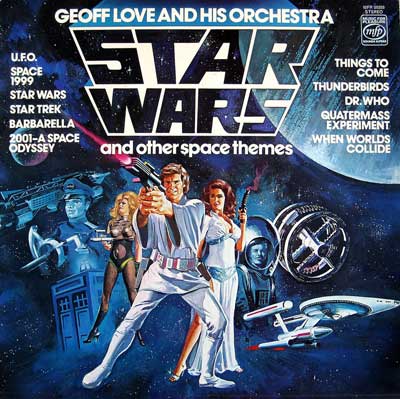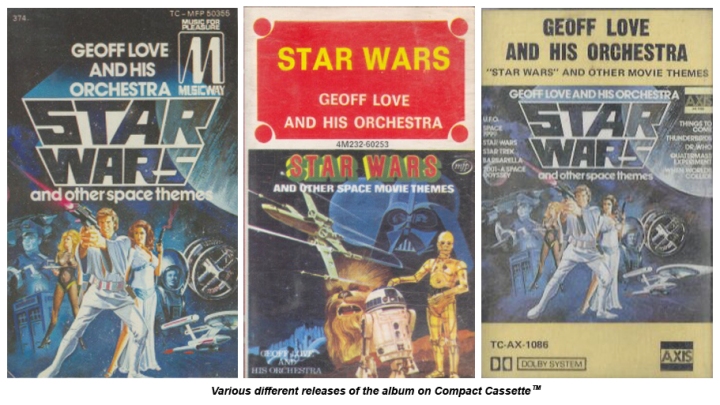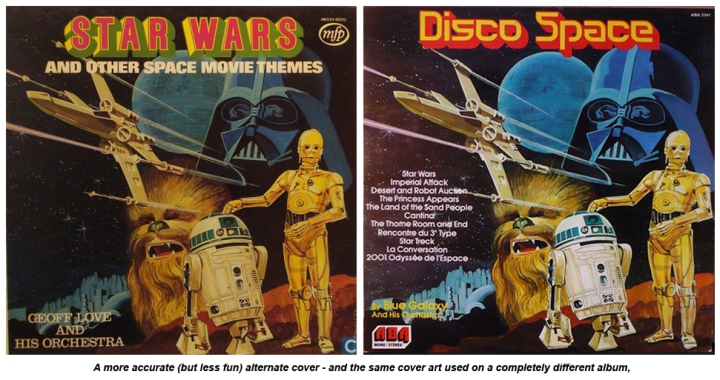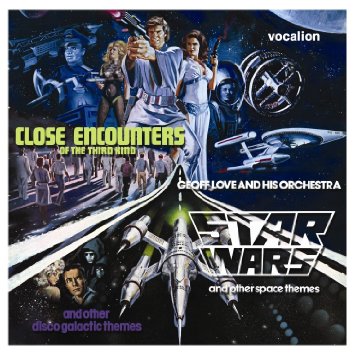
Originally published in Strange Skins Digital #1
This isn’t the first time I’ve discussed the work of Geoff Love in the pages of Strange Skins; way back in issue four of the original run, I wrote an overview of his work and anyone who read that will know that I don’t have much time for those who still think of Star Wars and Other Space Themes as a load of cheap tat. So, if you’re the sort of person who gets their Y-fronts in a knot every time a soundtrack album dares to run together two musical cues that aren’t consecutive in the movie, you’d better stop reading this now, because you’re really not going to enjoy it at all.
Star Wars and Other Space Themes was the first LP I ever bought (if you don’t know what an LP is, ask your Dad), purchased from a shop in Pallion Road, Sunderland which sold electronics, books and vinyl records. These kind of budget ‘fancy goods’ shops were quite common in the 1970s and their vinyl record music departments were always chock-a-block with cut-price Music for Pleasure LPs.
Music for Pleasure was the budget range of EMI in the United Kingdom. They produced mainly compilation records of everything from Mozart concertos to downright weird stuff like The Band of the Coldstream Guards playing the hits of Tom Jones, and amongst all this easy listening oddness, you would frequently find compilations of film and TV music.
The music on these LPs was generally played by an ad-hoc orchestra of session musicians, but they’d usually put a band leader with a publicly recognisable name in charge of them to increase sales; for example, Val Parnell, Tony Hatch or, of course, Geoff Love. Often recording as ‘Manuel and his Music of the Mountains’, Geoff Love worked frequently for MFP as an arranger and conductor on all manner of projects. In 1977, when the album was recorded, MFP were insistent on the inclusion of disco sounds; the dance-orientated beat being the new big thing and considered essential for commercial success. As varied as Geoff Love’s output for the label had been, he was uncertain about the disco boom and didn’t really understand how it could be incorporated into orchestral works. Enter: Nick Ingman, a composer and arranger with an impressive list of collaborations under his belt and, as a younger man, a stronger understanding of the disco sound.
Some of Britain’s biggest session players contributed to the Geoff Love Orchestra on this album, including bassist Herbie Flowers and drummer Barry Morgan, both fresh off Jeff Wayne’s Musical Version of the War of the Worlds mere weeks earlier. Love himself conducted, with Ingman on hand to give notes on the more dancefloor-influenced aspects of the production. As with all of these budget LPs, the recordings took no more than a couple of weeks, but the resulting sound is – at times – remarkable.
The pair worked together on a similarly themed second album a year later, the far inferior Close Encounters of the Third Kind and Other Disco Galactic Themes (real snappy, huh?) which, according to music business lore, was recorded in a day and a half – and it shows. Double cassette releases of the Star Wars LP often lumped it together with tracks from the Close Encounters LP (such as the turgid rendition of the Blake’s 7 theme), contributing to the poor reputation that the former album garnered throughout the 1990s. For the record (no pun intended) the original track listing of the 1977 release of Star Wars and other Space Themes was as follows:
Side One
o Star Wars (John Williams)
o UFO (Barry Gray)
o Star Trek (Alexander Courage)
o Barbarella (Charles Fox & Bob Crew)
o Space: 1999 (Barry Gray)
o Also Sprach Zarathustra (from 2001: A Space Odyssey) (Richard Strauss)
Side Two
o Things to Come (Sir Arthur Bliss)
o Thunderbirds (Barry Gray)
o Princess Leia’s Theme (John
Williams)
o Dr. Who [sic] (Ron Grainer)
o When Worlds Collide (Stevens)
o Mars – The Bringer of War (from The Quatermass Experiment) (Gustav Holst)

So, let’s take a look track-by-track, in celebration of the album and maybe we’ll convert a few more unbelievers along the way…
TRACK 1 – STAR WARS
For an album that has a reputation for funked-up disco renderings, the first track is decidedly devoid of funk. Nope, this is an absolutely straight rendition of John Williams’ classic main theme from Star Wars… and a rather splendid one too. There is a crummy disco version on the Close Encounters LP, but forget about that – this one is by far the better cut.
It follows the familiar opening march of the Star Wars movies up to the point where the theme veers off into incidental music. Some cover versions of the music flounder at this point (such as the fellow budget LP Star Wars – A Stereo Space Odyssey, which just stops dead) but Love and Ingman choose to loop back to the march and give the music the rousing end that it deserves.
The Orchestra that played this will have been a fraction of the size of the LSO on the original soundtrack, but they produce a big sound that does justice to the material. A suitably rousing start to a rather wonderful album.
TRACK 2 – U.F.O.
Orchestra crash! Get used to those; they’ll be in every pop song in another five years. A cheeky Morse code message (spelling out U.F.O. I think, my Morse is a bit rusty) heralds in a rousing version of Barry Gray’s theme from the live action Gerry Anderson series; the first of three Barry Gray cuts on the album.
It’s funkier than its predecessor, but still not to excess. There’s a disco kick-drum throughout, but the main thrust of the theme is faithful to the powerful brass sound associated with Gray. There’s also a kinky electric piano section, which will return in the theme from Thunderbirds.
The unfair criticism often levelled at this album is that it robs the themes of their gravitas, but that can hardly be said about U.F.O. The original theme from the TV series was pretty damned funky; all that Ingman does is drag it out of its late 60s groove and into a mid-70s one. Let’s be honest, if they’d put an entirely faithful version of the U.F.O. theme on this album, it’d have sounded really dated and out-of-place in 1977. The same can also be said of the Barbarella theme, coming shortly – but first this…
TRACK 3 – STAR TREK
This album comes at an odd time for Star Trek; the original series has long since finished and it’d be another couple of years before Star Trek – The Motion Picture hit the big screens. Only people in the know in Hollywood would have anticipated the return of the Starship Enterprise, so to most people, Star Trek was as much a part of sci-fi history as The Quatermass Experiment and When Worlds Collide.
Alexander Courage’s Star Trek theme is also a product of its time – and it’s a bitch to arrange with any sense of gravitas! The recent big screen reboot’s end credits prove that. So, Nick Ingman dispenses with any sense of drama and presents the Star Trek theme as a laid-back lounge jazz piece. Like cool, daddy-o.
It starts off with an insistent wah-wah guitar riff before dropping into a pulsing Herbie Flowers bass line. The main theme is delivered by sax, which is an odd choice and the whole thing discos up a bit in the middle. The track picks up towards the end when the brass starts counterpointing the main theme, but I have to confess this is probably my least favourite cut on the album. There’s nothing wrong with it per se, but it’s just a bit drab and lifeless.
TRACK 4 – BARBARELLA
The music for Barbarella was co-written by erstwhile Four Seasons producer Bob Crewe. Now, if you’ve seen either the play or the movie of Jersey Boys, you’ll know that Bob Crewe was a touch… let’s say flamboyant. Consequently, his theme song for the 1967 movie version of Barbarella was as camp as Boy Scout Jamboree and firmly mired in a sort of Summer of Love psychedelic go-go kitsch that was couldn’t have been more out of fashion in the mid-1970s if it’d been wearing spats and a straw boater. How could it possibly be updated for Star Wars and Other Space Themes?
Very well, as it turns out. Barbarella is one of the album’s big success stories. Starting with a rumbling doom-laden piano, it twangs off into an almost Hawaiian guitar riff before lapsing into and soaring strings and friendly-sounding synths to replace the vocals. It’s a really clever arrangement that reflects the fluffy fun of the source material without drowning you in cloying camp.
I was familiar with this version of the theme years before I ever saw Barbarella (which is now one of my all-time favourite movies) and at first I couldn’t get used to the original version. Now I love them both equally.
TRACK 5 – SPACE: 1999
Far from being funked up, Barry Gray’s lively theme for Gerry Anderson’s second live action TV series is actually funked down for this LP. The opening theme of the show is pretty damned funkae, if you recall, but this arrangement dials down the wah-wah guitars and goes for the brassier sound of the closing theme. There’s a great string arrangement on here, which seems to work with another memorable bass line from Mr. Flowers. It leads to a very pulsating beat which drives the tune along, but it’s firmly in the middle ground on the disco-meter, rarely if ever straying into full-on silver Rayon pants territory.
You can see why Barry Gray’s themes for the Gerry Anderson TV shows make up such a big part of this collection, as they work really well in this kind of arrangement. Gray was never what you would call a heavily classical composer and it’s ironic that the Thunderbirds march is his best known theme, as its purely orchestral arrangement on TV is actually fairly unique in his songbook. Most of his themes incorporate elements of the popular music of the time in which they were produced and Space: 1999 is no exception. I’m sure he would have approved of this very classy arrangement of what was to be his final Gerry Anderson theme.
TRACK 6 – ALSO SPRACH ZARATHUSTRA (FROM 2001: A SPACE ODYSSEY)
Before Star Wars reinvented science fiction for the big screen, the biggest sci-fi hit of the 20th century was Stanley Kubrick’s 2001: A Space Odyssey. Its main theme, an 1896 tone poem by classical composer Richard Strauss, became synonymous with all things outer space when the movie came out in 1968. Although generally referred to as Also Sprach Zarathustra (Thus Spake Zarathustra), that is actually the title of the suite; the part that was used in 2001: A Space Odyssey is specifically titled Sonnenaufgang (Sunrise).
This is one of two tracks on the album that was not recorded in the Star Wars and other Space Themes sessions. Although it is Geoff Love and his Orchestra (not necessarily the same orchestra), it was originally recorded for another Music For Pleasure LP called Big Suspense Themes, which might account for its distinctly unfunky arrangement. In fact, it’s a totally straight rendition of the original piece, complete with the middle section and reprise that are often ignored on other film music collections.
There are five straight orchestral pieces out of twelve tracks on Star Wars and other Space Themes, which is odd for an album that has a reputation for dated seventies funkiness. I think it’s the combination of the two types of music that make this LP something unique.

TRACK 7 – MARCH FROM ‘THINGS TO COME’
Side Two starts with an odd choice. The 1936 Korda Brothers production of Things To Come (adapted by HG Wells from his own novel The Shape of Things to Come) probably wouldn’t have been the first thing to come to mind when science fiction was mentioned in 1978, especially since it was already almost 40 years old.
However, Sir Arthur Bliss’s rousing march, heard as a recurring theme throughout the film, makes a welcome addition to this album. It’s another of the purely orchestral tracks on the album and a faithful rendition of the music from the film.
The criticism that comes up against this album again and again is that it is too disco but, as I just mentioned about 2001: A Space Odyssey, the pure orchestral tracks make a mockery of that criticism, as they are all really faithful interpretations of the music in question. But enough of this seriousness…
TRACK 8 – THUNDERBIRDS
A burst of booming kettle drums heralds the third and probably best known Barry Gray number on this album. You might have expected that the famous Thunderbirds march would be one of the purely orchestral tracks on here. It isn’t. Neither is it particularly funked up. It’s the kind of light, amiable orchestral pop arrangement that was very prevalent in the 1970s.
I can imagine there’ll be a lot of Gerry Anderson fans who hate this arrangement, in the same way that there are a lot of Doctor Who fans who hate the Doctor Who one, but hey, it’s cute and inoffensive and rattles along at a breathless pace. The lead line swaps between instruments as the Tracy Brothers might swap between vehicles; it starts off with a jaunty electric piano, swaps to sax and ends coming over all string section.
Somewhere in the middle it goes all Magnificent 7 for no adequately explained reason, but I think that only adds to its charm. It’s honestly hard to dislike this arrangement – the key word is fun, which is something I’ve always associated with Thunderbirds. And just when you’re feeling that sugar high, along comes…
TRACK 9 – PRINCESS LEIA’S THEME
On my original vinyl LP of Star Wars and Other Space Themes, this track is so scratched that it is literally unplayable. That’s because, throughout my childhood, I thought it was girly and boring and the next track was Dr. Who for God’s sake! So it got skipped over again and again, and my lack of delicacy with the needle had well and truly paid its price on the inexpensive vinyl.
Back in the days before film movie buffs got all arsey about soundtrack albums being an exact reproduction of the score, film composers often used to arrange little suites like this to show off their favourite character themes. This is a pretty little number built around John Williams’ theme for Princess Leia in Star Wars. This is a straight version of the John Williams arrangement and another of the LP’s purely orchestral numbers. It might start off hauntingly quiet but it quickly swells into a drama drenched (as they used to say in the old Marvel Comics) middle section.
I understand why, as a child, I was turned off by this track, but I’m glad to say that as an adult, I can see it for the quality piece that it really is.
TRACK 10 – DR. WHO
Doctor Who fans are very weird about their theme; they’ll accept almost any arrangement of it, as long as it’s in some way authorised. A lot of fans hate this version even if they’ve never heard it, simply because Doctor Who Magazine tells them it’s no good.
But there‘s something about this here arrangement almost everyone misses – which is that until the arrival of Murray Gold in 2005, Love and Ingman are the ONLY people to have scored an entirely orchestral arrangement of the Doctor Who theme as a Galop rather than a military March! Even the 1996 TV Movie version (which I personally hate) is scored in that awful rat-a-tat-tat staccato March time. The worst offender is the simply awful Eric Winstone Orchestra version; the first and almost certainly the most dreadful orchestral arrangement of Ron Grainer’s music.
Geoff Love’s version has a rolling quality, kept aloft by Herbie Flowers’ perfect bassline and Barry Morgan’s metronomic drums. It’s very easy to hear the similarities in the drum and bass parts of this LP and Flowers and Morgan’s work on Jeff Wayne’s The War of the Worlds. I know I keep on mentioning these two, but they are a pair of musicians with a solid gold pedigree; Morgan was the drummer on Alexis Korner’s Creative Consciousness Society’s version of Whole Lotta Love (heard on a weekly basis as the theme to Top of the Pops) and Flowers has a stunning catalogue including work with David Bowie and Marc Bolan, not to mention the classic sliding bass on Lou Reed’s Walk on the Wild Side.
I’ve drifted off into pop nostalgia – back to Dr. Who. As with Thunderbirds, the leading line switches instruments throughout the tune; starting with a clarinet, switching to some raunchy sax and finally some delightful soaring strings. This final section has an excellent passage where the horns counterpoint the strings in a sort of fanfare; the effect is breathtaking and I’m amazed that Murray Gold has never ‘borrowed’ it! The whole thing ends on a minor chord that adds a mysterious sound to the music. It almost seems to sing ‘Doctor… Who?’
TRACK 11 – WHEN WORLDS COLLIDE
This is another track that bored me a bit at first. However, then I got hold of a copy of another Geoff Love and his Orchestra LP, Big Terror Movie Themes, which presents smooth lounge jazz arrangements of the likes of The Towering Inferno and Three Days of the Condor. I fell in love with that album and since When Worlds Collide is very much in the same oeuvre, I fell in love with that too eventually.
It starts out gently, like a dance band at an old-fashioned function (which is apt, because that’s how this music is used in the film) and becomes more and more dramatic as the track continues. In best Star Wars and Other Space Themes style, it goes all disco in the middle, before easing back into the style in which it started.
This isn’t a particularly exciting or dramatic arrangement, but it’s cool and laid-back, giving respite from the bombast of a lot of the other numbers on this LP.
TRACK 12 – MARS: BRINGER OF WAR (FROM THE QUATERMASS EXPERIMENT)
Don’t tell anybody but I’ve got a secret. Come a little closer and I’ll whisper it to you. Are you ready…? This isn’t Geoff Love and his Orchestra. I know, you feel cheated, betrayed. You buy a Geoff Love and his Orchestra record; you expect Geoff Love and his Orchestra, right? Well, as I mentioned earlier, MFP were a budget outfit who would cut corners where necessary in order to bring you your records as cheaply as possible.
Mars: Bringer of War is actually a recording of the Hallé Orchestra conducted by Anton Kwiakowski from a classical LP of Gustav Holst’s The Planets Suite. By an amazing coincidence, I also had that LP for years (yes, I bought a classical LP as a kid – what can I say? I’m a geek) without realising it was the same recording. And I was inspired to buy The Planets Suite by having heard Mars: Bringer of War on Star Wars and Other Space Themes! It’s a small world… or at least it was in the Seventies.
I’d never heard of The Quatermass Experiment when I bought this LP in the 1979 and it wasn’t represented on the sleeve artwork, so it was down to my Uncle to explain about the serial. Not too long afterward, ITV brought the Professor back in Euston Films’ Quatermass (a.k.a. The Quatermass Conclusion) and there was a part of me expecting it to start with Mars: Bringer of War. It didn’t, of course, and I must admit to being a little disappointed. Later I saw the three Hammer Quatermass films, which also don’t feature this music, and Quatermass and the Pit on BBC Video, which doesn’t either. It wasn’t until I saw a pirate VHS of Quatermass II in the early nineties that I ever heard it in action.
I’ve digressed a lot, but that’s because there’s not a whole lot to say about this cut; it’s a faithful, powerful rendition of Holst’s piece and, although one of the shorter pieces in The Planets Suite, it still rocks in at a rollicking 7:42 minutes; the longest track on the LP. A rousing conclusion to this great record.
And that’s Geoff Love and his Orchestra’s Star Wars and Other Space Themes! Undervalued? Most certainly. Overlooked? For a great many years, yes, but that’s starting to change now, as a more open-minded generation of vinyl fans starts to look back nostalgically on the back catalogue of Music For Pleasure.

Sure, some may look on this as kitsch, but as long as they’re appreciating the creativity, the imaginative arrangements and the great musicians on this record, there are much worse things for your music to be thought of as. So, if reading this has made you want to live the Star Wars and Other Space Themes experience, you can usually find copies kicking around charity shops (if you’re a vinyl freak) or as a CD / download on Amazon.
Vocalion released an excellent double CD set back in 2012, featuring not only Star Wars and Other Space Themes, but also its twisted cellar-dwelling half-brother Close Encounters of the Third Kind and Other Disco Galactic Themes. I’m guessing that one of those will get a lot more playing than the other. Can you guess which one…?

A favourite album of mine, ever since I received it for Christmas many years ago.
Although the sleeve notes to Vocalion’s reissue state that ‘Mars, the Bringer of War’ is actually the Hallé Orchestra’s 1975 recording, it should be noted that Geoff Love conducted the London Philharmonic Orchestra in a version for his album ‘Music at War’ the same year. Both recordings were produced by Anton Kwiakowski. They sound very similar, but I’m not convinced that they are one and the same.
LikeLiked by 1 person
Great review Paul. I purchased this album from my local newsagent in country NSW, Australia back in 1979. I was drawn to the album by my love of science fiction and themes. The cover art work also played a part, it was well done but at the same time wrong and weird.
My initial listen left me disappointed, however I grew to love the album and the versions it contains. I don’t regard any tracks as being “Disco”. Some are definitely funky with the occasional disco flourish, but that’s about it.
Highlights for me are U.F.O., Barbarella, Space 1999, Thunderbirds and Leia’s Theme, plus Herbie’s bass playing. If you want to listen to the original version don’t listen to this album, however if you want versions re imagined in that special British version of soundtrack funk then this is the album for you.
P.S. As Paul suggested, don’t sully your ears with Close Encounters of the Third Kind and Other Disco Galactic Themes, and yes the Blake’s 7 version is horrendous.
LikeLike